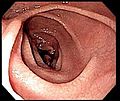Coeliac disease facts for kids
Coeliac disease is a condition where your body's immune system reacts badly to gluten. Gluten is a protein found in foods like wheat, rye, and barley. If you have coeliac disease and eat gluten, your body's defense system (immune system) mistakenly attacks the lining of your small intestine.
This attack damages the intestine. It makes it hard for your body to take in important nutrients from food. You might not get enough energy, vitamins, or minerals. For kids, this can mean not growing or gaining weight as they should. People with coeliac disease often feel very tired and might lose weight.
Contents
What Happens with Coeliac Disease?
People with coeliac disease can have different symptoms. These often include stomach pain, bloating, and diarrhea (watery poop). Sometimes, their poop can be fatty. These issues can also lead to more gas.
Other problems might include joint pains or skin rashes. Some people feel very tired all the time. Kids might grow more slowly or have a delayed puberty. Adults might lose weight or have weaker bones.
How Do You Treat Coeliac Disease?
The only way to treat coeliac disease is to stop eating gluten. There are no medicines or cures for it. When you stop eating gluten, your intestine can start to heal. This usually takes about two years.
You must stay on a gluten-free diet for the rest of your life. This helps your intestine stay healthy and stops symptoms from coming back.
Is Coeliac Disease Genetic?
Coeliac disease can run in families. If a close relative like a parent or sibling has it, you have about a 1 in 10 chance of getting it too. This means you are born with genes that make your body react to gluten.
However, not everyone with these genes gets coeliac disease as a child. It can sometimes start later in life. Events like pregnancy or other illnesses can trigger it in adults.
How Do Doctors Find Coeliac Disease?
Doctors can check for coeliac disease in a few ways. They often start with a blood test. This test looks for special proteins called antibodies. These antibodies are what your body makes to attack the intestine when you eat gluten.
Normally, antibodies help fight off sickness. But with coeliac disease, one type of antibody thinks gluten is harmful. Doctors can also look inside your intestines. They use a thin tube with a camera called an endoscope. This helps them see if your intestine is damaged from coeliac disease.
Images for kids
See also
 In Spanish: Celiaquía para niños
In Spanish: Celiaquía para niños






